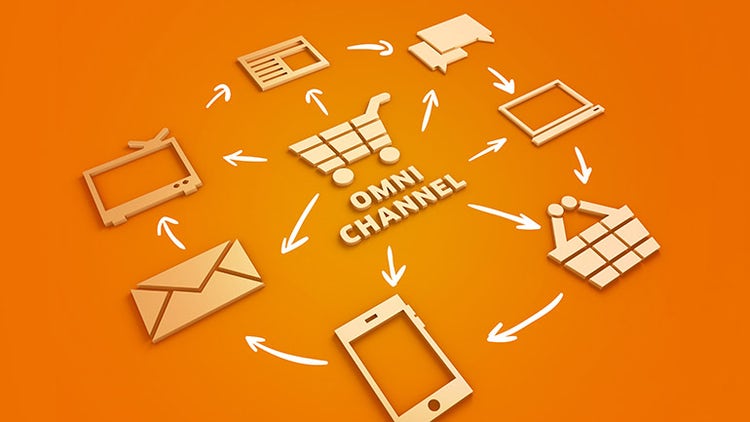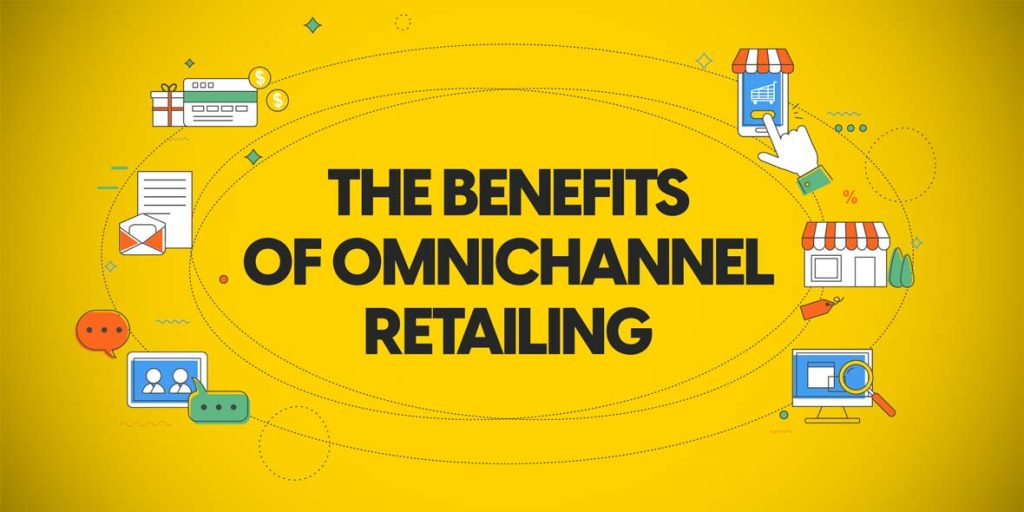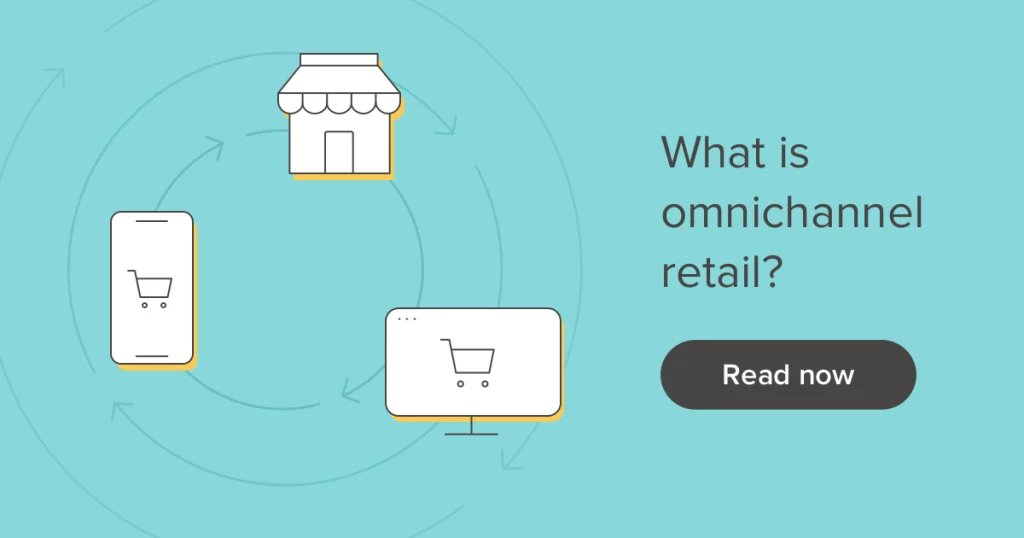In today’s digital age, omnichannel retail isn’t just a perk – it’s a fundamental element for any thriving ecommerce business. The way consumers shop has dramatically shifted, with many embracing online channels more than ever before.
This trend is undeniable. Research shows a clear move towards omnichannel strategies, with a significant portion of decision-makers recognizing its importance. Additionally, experts predict a continuous rise in multichannel (often used interchangeably with omnichannel) sales, highlighting the growing preference for a seamless shopping experience across various channels.
Omnichannel retail goes beyond just offering products online. It’s a comprehensive strategy that creates a unified journey for customers, no matter how they interact with your brand. From initial discovery to final purchase, the experience should be smooth and consistent. This approach is already proving its worth, with businesses reporting significant revenue growth after implementing omnichannel strategies.
Consumers are constantly bombarded with new ways to discover products, and they expect modern conveniences to streamline their shopping decisions. This article will delve into how you can integrate your online and offline channels, along with all your operations, to create a cohesive and enriching experience across every touchpoint.
Understanding Omnichannel Retail

Omnichannel retail goes beyond simply selling across various platforms like marketplaces, social media, and physical stores. It’s about creating a unified shopping experience for your customers, no matter where they interact with your brand.
While “omnichannel” might be a trendy term, it signifies a step up from just being “multichannel.” Let’s explore the key differences:
1. Omnichannel Retailing
This approach prioritizes a consistent brand experience across all touchpoints. It’s about meeting customers where they are and fostering relationships that go beyond individual channels. Additionally, omnichannel emphasizes optimizing your business model by diversifying your channels and seamlessly integrating your data and systems.The demand for omnichannel retail is undeniable. In today’s landscape, customers increasingly expect a seamless journey, and studies show this preference is growing. Nearly 90% of consumers desire an omnichannel experience, and the average consumer interacts with almost six touchpoints before making a purchase – a significant jump from just two channels 15 years ago. Omnichannel retail isn’t just about expanding your reach; it’s become an essential element that customers now actively seek.
2. Multichannel Retailing
Similar to omnichannel, multichannel involves selling across multiple channels. However, multichannel experiences can often feel disjointed, with marketing efforts operating in isolation and lacking a unified message across channels. Here, the focus tends to be on optimizing each touchpoint individually, rather than considering the entire customer journey.3. Single Channel Retailing
Unlike omnichannel and multichannel retailers, some businesses choose to operate on a single channel. This could involve selling solely through their own online store or relying exclusively on a marketplace platform like Amazon.Different Avenues of Omnichannel Retail
Omnichannel retail thrives across a vast landscape, from established online marketplaces to dynamic social media platforms. Here, we’ll explore some key avenues to consider when building your omnichannel strategy.
1. Amazon
A titan in the online marketplace world, Amazon boasts an impressive 2.45 billion monthly visitors – nearly triple its closest competitor. This translates to vast exposure for businesses utilizing Amazon as a sales channel. Additionally, sellers benefit from Amazon’s robust fulfillment network, ensuring fast, reliable deliveries regardless of location. Furthermore, Amazon boasts a massive pool of loyal customers, including over 200 million Prime members, and gathers valuable consumer data that can be used for targeted marketing efforts.
2. Walmart
Another retail powerhouse, Walmart offers significant advantages for omnichannel businesses seeking to expand their reach. Walmart.com attracts 120 million unique monthly visitors, providing a sizable potential customer base. Additionally, Walmart offers fast delivery options like in-store pickup and free next-day/two-day deliveries, along with a customer-friendly return policy. Sellers on Walmart.com also benefit from substantial seller tools, including robust advertising options, comprehensive reporting, and in-depth analytics. Interestingly, Walmart boasts a less saturated seller environment compared to Amazon, with sellers averaging roughly 27,000 monthly visitors on Walmart.com versus just 2,100 on Amazon.
3. Mercado Libre
Often dubbed the “Amazon of Latin America,” Mercado Libre is a rapidly growing e-commerce platform that unlocks omnichannel potential for businesses looking to expand globally. As Latin America’s leading e-commerce marketplace, Mercado Libre boasts over 65 million shoppers across 18 countries. This presents a significant opportunity for businesses to tap into a new and dynamic market.
4. Wish
A popular global shopping app with over 120 active countries, Wish offers a seamless integration for businesses, particularly those utilizing BigCommerce platforms. This includes dedicated account management support for onboarding, listing optimization, merchandising strategies, and maximizing product visibility.
The Rise of Omnichannel Shopping
The way we shop has fundamentally changed. The past few years have seen a surge in online commerce, with a significant portion of total retail sales predicted to happen online by 2025. This isn’t just about a shift from physical stores to websites. Consumers are embracing a more flexible approach, utilizing various channels throughout their shopping journey.
This change isn’t simply a product of the pandemic. While COVID-19 accelerated the trend, it also highlighted the need for retailers to adapt and offer a unified shopping experience. Whether it’s browsing online or visiting a physical store, customers expect a seamless connection across all touchpoints.
The shift goes beyond just choosing different channels. Shopping habits have evolved in other ways too. Consumers are open to trying new brands and products, influenced by the online landscape. Additionally, new shopping constraints, like a preference for curbside pickup, have emerged.
For retailers, this presents an opportunity. By understanding these evolving customer behaviors, businesses can cater to their needs and preferences. This “new normal” will see a more informed and adaptable customer base, requiring retailers to adjust their strategies to this omnichannel reality.
Why Omnichannel Retail is Essential for Retailers

The way customers shop has undergone a dramatic shift, and omnichannel retail has become the key to keeping pace. This shift has been particularly pronounced in recent years, pushing retailers to adapt their strategies.
Traditionally, convenience was often a secondary concern for shoppers. However, with the rise of online shopping and on-demand services, convenience has become a top priority. Omnichannel retail addresses this head-on by providing a seamless shopping experience across all channels.
Imagine a customer browsing products online, then visiting a physical store to try them on before completing the purchase seamlessly through their phone. This kind of smooth integration between channels is what omnichannel retailing offers. Ultimately, it translates to happier customers who spend more and come back for more, boosting both sales and profitability for retailers.
Meeting Customers on Their Terms in the Omnichannel Age
The way we shop has undergone a dramatic shift, even before the recent global disruptions. While the desire to acquire things remains a constant, the channels through which customers discover, research, and ultimately purchase have exploded.
Ecommerce has become an essential element, not a novelty. Social media platforms, with their captive audiences, have embraced features that facilitate buying directly within their apps. Marketplaces have seen a surge in traffic, offering a vast selection of products under one digital roof.
Gone are the days of the linear shopping journey. Customers today embark on a winding path, encountering new brands and products through diverse avenues. Targeted ads on Facebook and Instagram, Google Shopping searches, browsing Amazon and other marketplaces, reading product reviews, in-store discoveries, and word-of-mouth recommendations all play a part. This exploration can happen on desktops, laptops, tablets, or smartphones – the device is entirely up to the individual.
By being present in the spaces your customers frequent, you make their shopping journey more convenient. This convenience is paramount in today’s world, but it’s worth noting that it has always been a key factor. Even before the pandemic, a pre-crisis survey by the NRF revealed that 83% of shoppers prioritized convenience as more important than it had been five years earlier.
Sharon Gee, General Manager of Omnichannel at BigCommerce, emphasizes the importance of adapting to this changing customer behavior. “Customers crave simplicity when it comes to managing their shopping needs,” she states. “A robust omnichannel strategy acknowledges these shifts and implements the technology and operational processes to meet customers where they are – and anticipate where they’ll be looking for you next.”
Standing Out in the Omnichannel Retail Arena
In today’s crowded online marketplace, differentiation is crucial for success. To truly thrive, retailers need to cultivate a stronger brand identity, provide a more enjoyable shopping experience, and deliver exceptional customer service.
Omnichannel retail provides a powerful tool for businesses to set themselves apart, especially those clinging to traditional brick-and-mortar models. With so many competitors vying for attention, why wouldn’t retailers seize any available edge? Embracing omnichannel retail instantly separates your brand, boosting your existing customer base while opening doors to entirely new markets.
To truly stand out, however, continuous adaptation is key. Consumer needs and behaviors are constantly evolving, necessitating a recalibration of your understanding of your target audience. Some of your long-held customer assumptions might need revising. Consider leveraging data to determine if adjustments are needed in areas like:
- Product Mix: Are there new product categories your customers are interested in?
- Shopping Channels: Where are your customers spending their time online?
- Marketing Strategies: Which advertising channels resonate most with your target audience?
- Brand Messaging: Is your brand voice still connecting with your customers?
By consistently refining your approach based on data and customer insights, you’ll be better equipped to navigate any unforeseen market shifts and solidify your position in the competitive omnichannel retail landscape.
Leverage Data for Smarter Omnichannel Retail
The dramatic shift in consumer behavior demands a reevaluation of sales and marketing channels to thrive in the new reality of omnichannel retail. Data analysis holds the key to identifying the most effective avenues for your business.
By harnessing customer data across your online store, social media platforms, physical stores, and even customer interactions, you gain a comprehensive view of your brand’s performance. Understanding the “why” behind customer decisions empowers you to tailor your approach and drive success.
Omnichannel adoption presents its own challenges. Consistent collaboration across all channels is crucial to optimize data analysis, preventing errors and ensuring valuable insights aren’t missed.
A robust omnichannel strategy allows you to centralize data from all sources, enabling smarter decisions. This empowers you to optimize inventory levels, meet customers on their preferred platforms, and deliver exceptional service across every touchpoint.
Personalization
Omnichannel retail gives you a unique advantage: a complete picture of your customers. By gathering data from every touchpoint, from in-store interactions to online browsing habits, you gain a deeper understanding of their individual needs and preferences.
This valuable information allows you to tailor your messaging and marketing strategy with laser focus. Imagine sending targeted recommendations based on a customer’s recent searches, or highlighting products similar to past purchases. This kind of personalization makes them feel truly seen and valued, a key factor in today’s competitive market.
Studies show that customers crave a curated experience – one that caters specifically to their interests. In fact, a significant portion of shoppers (74%) are likely to abandon a website that feels generic. With omnichannel personalization, you can create a shopping journey that feels unique and relevant to each individual, ensuring a more satisfying experience and ultimately, a happier customer.
Building Your Omnichannel Strategy

Creating a seamless customer journey across all your sales and marketing channels is a key part of omnichannel retail. It’s like conducting an orchestra – each touchpoint plays a role in creating a harmonious experience.
The exact approach will vary depending on your business goals and target audience. A bakery targeting busy professionals might prioritize mobile app ordering and quick in-store pickups, while a high-end furniture store might focus on personalized consultations and in-home experiences.
Here’s a roadmap to get you started:
1. Know Your Audience
This is where customer segmentation comes in. By dividing your audience into distinct groups with similar needs and preferences, you can tailor your approach for maximum impact. Consider factors like demographics, purchase history, and online behavior to create these segments.
Why it Matters: Imagine shouting your message to a crowded room instead of having individual conversations. Segmentation lets you speak directly to each customer group, increasing engagement and sales.
2. Channel Mapping
Once you know your audience, you need to understand where they shop and interact online and offline. Popular channels include websites, social media platforms, marketplaces, and physical stores.
Think Like Your Customer: Imagine you’re looking for a new pair of athletic shoes. You might browse reviews on a sports apparel website, compare prices on a shopping aggregator, and then head to a local store to try them on before you buy. By understanding your customer’s journey across different channels, you can be there for them at every step.
Data is Your Friend: Use a combination of qualitative and quantitative data to identify your most valuable channels. Talk directly to customers to gain insights into their motivations and preferences. Complement this with website analytics to see which channels generate the most sales and drive new customer acquisition. By focusing your efforts on the most effective channels, you can maximize your return on investment.
3. Mapping the Customer Journey
Understanding what channels your customers frequent is crucial, but it’s just one piece of the puzzle. Omnichannel retail demands uncovering the “why” behind their actions. By mapping the customer journey, you gain valuable insights into their thought processes and identify what resonates with them.
Imagine you’re on the hunt for a trendy gold watch. Here’s a possible journey:
- You browse “gold watches” on Pinterest, seeking inspiration.
- Intrigued by a few brands’ aesthetics, you delve into their Instagram profiles.
- Retargeting ads from various jewelry stores start appearing – you click on those that pique your interest.
- You subscribe to email lists from a handful of brands for exclusive offers.
- To make an informed decision, you research “[brand name] reviews” for top contenders.
- Finally, you pick your favorite and purchase it directly from their online store.
This is just one scenario – the journey could easily have taken different turns. Regardless of the path, customers expect a smooth experience across all touchpoints. Herein lies the biggest challenge of omnichannel retail. As McKinsey aptly states, “Customer journeys are not linear. They’re a series of handoffs between traditional and digital channels, varying by customer type. An effective strategy hinges on understanding what truly drives their decisions.”
4. Seamless Customer Support Across All Channels
In today’s omnichannel retail world, convenience reigns supreme for customers – and that applies to customer support as well. If you’re actively engaging on multiple platforms, ensuring consistent support across all of them is crucial.
Imagine a customer who discovers your product through a social media ad, clicks through, and lands on your website. Unfortunately, the link they clicked malfunctions. They’re interested in the item but can’t find it on your site. Who should they reach out to for help – the platform they saw the ad on or your company directly?
With disconnected support teams, this customer could easily get frustrated and abandon the purchase altogether, leaving everyone disappointed. By building a unified cross-channel support system, such situations are avoided. Customers receive seamless assistance no matter where they are on their shopping journey or which platform they use.
Providing consistent, high-quality support fosters trust and loyalty, ultimately increasing customer lifetime value.
5. Technology Integration
One of the cornerstones of a successful omnichannel strategy is a well-integrated tech stack. Inventory management is a prime example. As you expand your sales channels, a real-time, unified view of your entire inventory is essential. Similarly, a single source of truth for product information, like a Product Information Management (PIM) system, eliminates the need to re-enter data for every platform you sell on.
Data feed management services streamline data across channels, while multichannel selling tools allow you to connect and synchronize accounts on major marketplaces like Amazon and eBay. The benefits extend far beyond inventory and product data. Tight integration between marketing and e-commerce efforts allows you to aggregate key data for better performance analysis and opportunity identification. Seamless handoffs between channels also significantly enhance customer support. A phone representative with access to a customer’s email history can pick up the conversation right where it left off, creating a smooth and personalized experience. As McKinsey highlights, well-executed customer support, powered by advanced analytics and technology, holds immense potential to boost customer satisfaction and create memorable “wow moments.”
6. Leverage Automation for Omnichannel Efficiency
Traditionally, businesses spend a lot of time on repetitive tasks that don’t require high-level strategic thinking. Omnichannel retail amplifies this challenge as you manage multiple channels. Here’s how automation empowers you to focus on what truly matters.
- Free Up Your Team for Strategic Initiatives: Automate tasks like answering basic customer questions through chatbots, allowing your support staff to tackle more complex inquiries.
- Gain Real-Time Insights: Prioritize a tech stack that seamlessly connects your channels. This provides a holistic view of your business and lets you make data-driven decisions.
- Personalized Marketing Across Channels: Set up automated triggers to deliver targeted messages. This ensures potential customers see the right content at the right time, regardless of where they are in their buying journey.
- Recover Abandoned Carts & Boost Sales: Utilize automation tools to recover abandoned carts. This can involve reminding customers about forgotten purchases and offering incentives to complete the checkout process.
- Strengthen Customer Relationships: Automate follow-up emails thanking customers for purchases and suggesting relevant products for future needs. This promotes a feeling of community and repeat business.
7. Continuous Testing for Omnichannel Success
Testing shouldn’t be a last-minute scramble. It’s an ongoing process crucial for omnichannel success. Here’s how to make testing a habit:
- Test Everything, Everywhere: Continuously test all aspects of your omnichannel strategy. This includes desktop browsing experiences, mobile app functionality, and how your systems respond to customer interactions.
- Refine Your Targeting: Experiment with different marketing elements like subject lines, content formats, and offers to see what resonates with your audience. Test your customer segments and explore opportunities for further refinement.
- Embrace Data-Driven Optimization: Aim for automated testing wherever possible. This provides real-time performance data across your business, allowing you to identify areas for improvement and make data-driven adjustments. Remember, gathering data at every touchpoint is critical for making informed decisions that elevate your omnichannel strategy.
This revised section maintains a similar structure to the original while focusing on the benefits of automation and continuous testing within an omnichannel context. It avoids specific data points and instead emphasizes the overall value these practices bring to omnichannel retail success.





